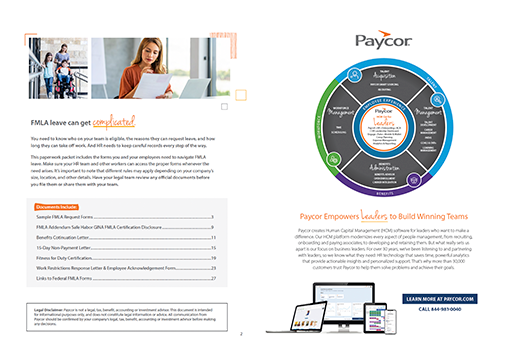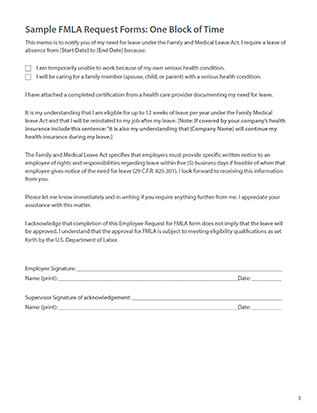If your company has 50 or more employees, you should be prepared to offer FMLA leave. This type of leave offers eligible workers time off to attend to medical or family issues. For HR, it can be a major compliance issue.
In this article, we’ll cover the basics of FMLA regulations: what they are, who qualifies, and how to manage compliance. For example, HR needs to have certain forms ready whenever an employee requests FMLA leave. Download our FMLA Paperwork Packet for free templates and customize them to meet your company’s needs.
What is the Family Medical Leave Act (FMLA)?
The Family and Medical Leave Act (FMLA) is a federal law that allows eligible employees to take up to 12 weeks of unpaid leave in any given 12-month period for certain family and medical reasons without fear of losing their job. Signed into law in 1993, the FMLA regulations help employees balance work and family responsibilities while promoting equal employment opportunities for men and women.
Who is Eligible for FMLA?
An employee is eligible for FMLA leave if they have:
- Worked for a covered employer for at least 12 months,
- completed at least 1,250 hours of work during the past 12 months, AND
- worked at a location within 75 miles of where the company employs 50+ people as full-time or part-time employees.
Independent contractors are not eligible for FMLA leave. An employer’s number of employees (counting toward the quota of 50+ people) must include those who:
- Work in the U.S. or any territory or possession of the U.S.
- Are named in the payroll records, whether or not compensation is received for a particular workweek
- Work for foreign businesses operating in the U.S.
- Are full-time, part-time, temporary, or seasonal
- Are on paid or unpaid leave (including FMLA, vacation or sick leave, suspension, etc.) as long as you have reasonable expectation that the employee will return to active employment
What Is an FMLA-Covered Employer?
FMLA regulations only apply to employers who meet certain criteria. These employers are:
- Private-sector employers with 50 or more employees (for at least 20 weeks/year)
- Public agencies, including local, state, or federal government agencies regardless of the number of employees
- Public or private elementary or secondary schools, regardless of the number of employees
What Reasons Can an Employee Take FMLA?
According to the U.S. Department of Labor, eligible employees can take FMLA for any of the following reasons:
- The birth and care of a newborn child
- To care for an adopted child or a child placed with the employee through foster care
- To care for a spouse, child, or parent with a serious health condition, including incapacity as a result of pregnancy or for prenatal medical care
- Medical leave when the employee is unable to work because of a serious health condition
- If you are the guardian of your sibling who is under 18 years old or older and incapable of self-care due to a mental or physical disability, you may take FMLA leave if they have a serious health condition.
- Eligible employees can take up to 26 weeks of leave in a 12-month period to care for a family member who is in the armed forces and is called to active duty or is suffering from a serious injury or illness.
Employee Responsibilities for FMLA
Whenever possible, employees should give at least 30 days’ notice when the leave is anticipated, such as for a planned surgery. The employee is also responsible for scheduling leave at a time that is minimally disruptive to your company’s operations. If the leave is unanticipated, such as emergency surgery, the employee must give notice as soon as possible.
At the employer’s request, the employee must submit a certification to prove the need for FMLA leave. The certification is typically a document completed by the employee and a healthcare provider to verify that the employee or family member has a serious health condition.
Employer Responsibilities for FMLA
After HR determines an employee is eligible for FMLA, you must provide a Notice of Eligibility & Rights and Responsibilities to the employee within five business days of the initial request. If the employee is not eligible, the Eligibility Notice must explain why.
When an employee asks for time off for an FMLA-qualifying reason, they don’t have to mention FMLA by name. It’s HR’s responsibility to recognize whether the leave request meets FMLA criteria. However, if the employee later requests additional leave for the same condition, they must reference the qualifying reason or the need for FMLA.
Within five days of determination, HR should provide the employee with a Designation Notice informing them that the requested leave will be designated as FMLA leave. The notice also has to include:
- The amount of leave that will count against the employee’s FMLA leave entitlement, if known
- Whether the employee is required to use paid leave before using unpaid FMLA leave
- Whether the employee is required to submit a fit-for-duty certification before returning to work
During FMLA leave, HR is obligated to maintain the employee’s group healthcare plan coverage. When the employee returns, you have to give them the same or equivalent job they held when they left. An “equivalent job” is one that’s nearly identical to the original job regarding pay, benefits, and other terms and conditions (including job shift and location).
What if 12 Weeks Isn’t Enough?
If an employee needs to take more time off than would be covered by FMLA leave, their condition may fall under the Americans with Disabilities Act (ADA). In that case, they would be entitled to continued job protection during their absence, as long as their leave doesn’t create undue hardship for the company.
If the employee asks to extend their leave, HR should engage in an interactive process. Do your due diligence to confirm whether their condition falls under ADA regulations and find out how much time they’ll need away from work. Then, you can decide whether the additional leave would cause undue hardship. Be aware, however, that “undue hardship” is a hard bar – this is rarely an issue when employees request leave.
HR can choose to offer additional leave to an employee even if their condition is NOT covered under the ADA. For top performers, this can be a valuable retention strategy. However, doing this with some employees can set a precedent for other people on the team, so give it careful consideration first.
How to Manage FMLA Compliance
Non-compliance with the FMLA poses a major financial risk for companies. Here are a few ways to stay on top of FMLA compliance:
- Educate Employees: Our HR and benefits administration platform can help you keep employees informed. In many states, you’re required to hang posters and send out notices about various details of FMLA.
- Proactively Track Absences: Paycor’s HR and timekeeping solutions can alert you to any absences that may qualify for FMLA leave.
- Document FMLA Hours: Paycor’s HCM software solution allows you to record each employee’s FMLA leave and attach relevant documents, like notes from health care providers.
If you’re just building out a workflow for FMLA administration, it’s important to have certain forms on hand. Our free FMLA Paperwork Packet can help you get started. Download the packet, customize each form to meet your company’s needs, and share them with your team as needed.











